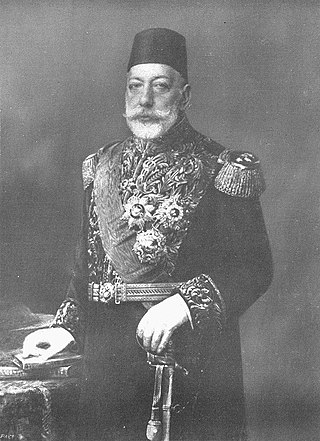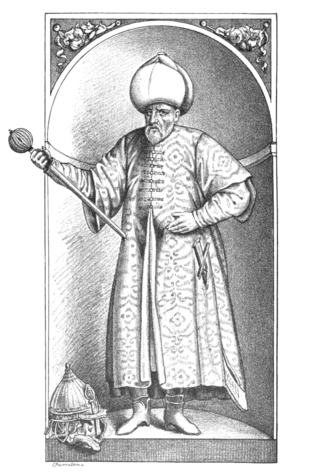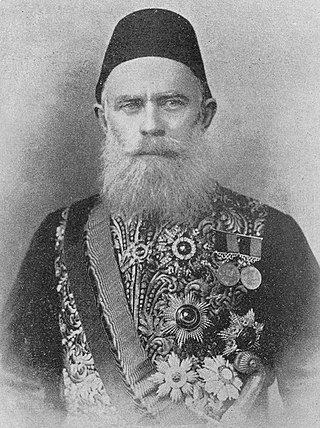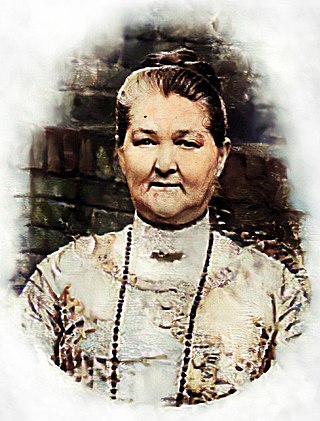
Mehmed II, commonly known as Mehmed the Conqueror, was twice the sultan of the Ottoman Empire from August 1444 to September 1446 and then later from February 1451 to May 1481.

Mehmed III was the sultan of the Ottoman Empire from 1595 until his death in 1603. Mehmed was known for ordering the execution of his brothers and leading the army in the Long Turkish War, during which the Ottoman army was victorious at the decisive Battle of Keresztes. This victory was however undermined by some military losses such as in Gyor and Nikopol. He also ordered the successful quelling of the Jelali rebellions. The sultan also communicated with the court of Elizabeth I on the grounds of stronger commercial relations and in the hopes of England to ally with the Ottomans against the Spanish.

Mehmed VI Vahideddin, also known as Şahbaba among the Osmanoğlu family, was the last sultan of the Ottoman Empire and the penultimate Ottoman caliph, reigning from 4 July 1918 until 1 November 1922, when the Ottoman sultanate was abolished and replaced by the Republic of Turkey on 29 October 1923.

Mehmed IV, also known as Mehmed the Hunter, was the sultan of the Ottoman Empire from 1648 to 1687. He came to the throne at the age of six after his father was overthrown in a coup. Mehmed went on to become the second-longest-reigning sultan in Ottoman history after Suleiman the Magnificent. While the initial and final years of his reign were characterized by military defeat and political instability, during his middle years he oversaw the revival of the empire's fortunes associated with the Köprülü era. Mehmed IV was known by contemporaries as a particularly pious ruler, and was referred to as gazi, or "holy warrior" for his role in the many conquests carried out during his long reign.

Mehmed V Reşâd was the penultimate sultan of the Ottoman Empire from 1909 to 1918. Mehmed V reigned as a constitutional monarch, interfering little when it came to government affairs, though the constitution was held with little regard by his ministries. The first half of his reign was marked by contentious politicking between factions of the Young Turks, and the second half by war and domination of the Committee of Union and Progress and the Three Pashas.

Sokollu Mehmed Pasha was an Ottoman statesman of Serbian origin most notable for being the Grand Vizier of the Ottoman Empire. Born in Ottoman Herzegovina into an Orthodox Christian family, Mehmed was recruited as a young boy as part of so called "blood tax" to serve as a janissary to the Ottoman devşirme system of recruiting Christian boys to be raised as officers or administrators for the state. He rose through the ranks of the Ottoman imperial system, eventually holding positions as commander of the imperial guard (1543–1546), High Admiral of the Fleet (1546–1551), Governor-General of Rumelia (1551–1555), Third Vizier (1555–1561), Second Vizier (1561–1565), and as Grand Vizier under three sultans: Suleiman the Magnificent, Selim II, and Murad III. He was assassinated in 1579, ending his near 15-years of service to several Sultans, as sole legal representative in the administration of state affairs.

Mustafa Reşid Pasha was an Ottoman statesman and diplomat, known best as the chief architect behind the Imperial Ottoman government reforms known as Tanzimat.

Izmail, is a city and municipality on the Danube river in Odesa Oblast in south-western Ukraine. It serves as the administrative center of Izmail Raion, one of seven districts of Odesa Oblast, and is the only locality which constitutes Izmail urban hromada, one of the hromadas of Ukraine.

Zaganos or Zagan Pasha was an Albanian Ottoman military commander, with the titles and ranks of kapudan pasha and the highest military rank, grand vizier, during the reign of Sultan Mehmed II "the Conqueror". Originally a Christian, who was conscripted and converted through the devşirme system, he became a Muslim and rose through the ranks of the janissaries. He became one of the prominent military commanders of Mehmed II and a lala – the sultan's advisor, mentor, tutor, councillor, protector, all at once. He removed his rival, the previous Grand Vizier Çandarlı Halil Pasha the Younger, amid the fall of Constantinople. He later served as the governor of Thessaly of Macedonia.

Ahmed Cevdet Pasha or Jevdet Pasha in English was an Ottoman scholar, intellectual, bureaucrat, administrator, and historian who was a prominent figure in the Tanzimat reforms of the Ottoman Empire. He was the head of the Mecelle commission that codified Islamic law for the first time in response to the Westernization of law. He is often regarded as a pioneer in the codification of a civil law based on the European legal system. The Mecelle remained intact in several modern Arab states in the early and mid-20th-century. In addition to Turkish, he was proficient in Arabic, Persian, French and Bulgarian. He wrote numerous books on history, law, grammar, linguistics, logic and astronomy.

The Second Constitutional Era was the period of restored parliamentary rule in the Ottoman Empire between the 1908 Young Turk Revolution and the 1920 dissolution of the General Assembly, during the empire's twilight years.

The Battle of Kagul or Cahul occurred on 1 August 1770 during the Russo-Turkish War of 1768–1774. It was the decisive and most important land battle of the war and one of the largest battles of the 18th century. It was fought in Moldavia, near the village of Frumoasa, nearly a month after the Russian victory at Larga.

The siege of Izmail or Ismail / Ishmael / İzmail, also called the storming of Izmail, was a military action fought in 1790 on the Black Sea during the Russo-Turkish War (1787–1792) and simultaneously the Austro-Turkish War (1788–91). The Russians were led by Alexander Suvorov, who had defeated the Ottomans at Kinburn, Focsani, and Rymnik, as well as participating in the siege of Ochakov. The Black Sea rowing flotilla was commanded by the Spanish admiral José de Ribas.

The following outline is provided as an overview of and topical guide to the Ottoman Empire:
Tayyar Mehmed Pasha was an Albanian Ottoman grand vizier. His epithet Tayyar means "flying", referring to his speed in military operations.
Ivaz Mehmed Pasha, also known as Hacı Ivaz Mehmed Pasha or Hacı Ivazzade Mehmed Pasha, was an 18th-century Ottoman grand vizier and provincial governor.

The Committee of Union and Progress, refers to several revolutionary groups and a political party active between 1889 and 1926 in the Ottoman Empire and the Republic of Turkey. The foremost faction of the Young Turks, the CUP instigated the 1908 Young Turk Revolution, which ended absolute monarchy and began the Second Constitutional Era. After an ideological transformation, from 1913 to 1918, the CUP ruled the empire as a dictatorship and committed genocides against the Armenian, Greek, and Assyrian peoples as part of a broader policy of ethnic erasure during the late Ottoman period. The CUP and its members have often been referred to as Young Turks, although the movement produced other political parties as well. Within the Ottoman Empire its members were known as İttihadcılar ('Unionists') or Komiteciler ('Committeemen').

Şayeste Hanım was a consort of Sultan Abdulmejid I of the Ottoman Empire.

Nallı Masjid, also known as İmam Ali Mescidi or Babıali Mescidi, is a late 19th-century small mosque located at Ankara Street northwest of the historic Sublime Porte building, at Cağaloğlu quarter of Fatih district of old Istanbul, Turkey.















